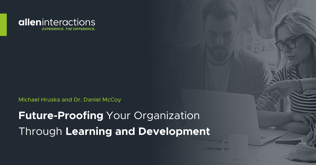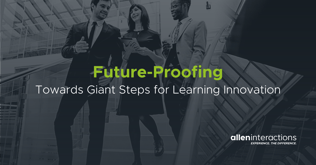Blog
Future-Proofing Your Organization Through Learning And Development
We are living in a state of accelerated change.

.png?width=1387&height=526&name=2023%20Blog%20Covers%20and%20In-Line%20Graphics%20(9).png)
3 Steps to Becoming an Adaptive Learning Organization
By Michael Hruska | February 08, 2023 | Custom Learning | 0 Comments
We are living in a state of accelerated change.
As learning leaders, we all have our toolkits for thinking about change, dealing with change, or making change. These tried and true tools may have worked to some level of effectiveness in our worlds. Most of us worked in a challenging environment pre-pandemic, and we likely face a different set of challenges in addition to the already existing set.
Organizations face broad and rapid changes to market shifts, customer experience, supply chain, workforce, and many others. If organizations want to survive, much less thrive, they cannot conduct business as usual. They need to adapt to external conditions. In fact, a ready stance around change is becoming a normal expectation for people supporting organizations.
This new required agility and flexibility for a transformative level of change require adaptation at the organizational level. Given the function and outcomes that L&D can produce in organizations, the L&D team is more important than ever to power the adaptive organization of the future.
The whole organization, not just leadership, will need to think differently, act differently, and work differently. There are mindsets, steps, and tools that can help your organization move towards becoming an Adaptive Learning Organization to support your organization's needed stance to thrive and become future-proofed.
Transformation implies that this is a one-time move to make a change. These types of changes are more complex. They require thinking about transformation pathways that will evolve incremental working elements of our L&D organization. We need to consider our transformation pathways and the signposts as we evolve and make progress.
3 steps to becoming an adaptive organization
Organizations that are successful at building the capabilities to future-proof themselves generally follow three steps:
-
Understand the current baseline and explore how to align with the Principles of Adaptive Learning Organizations
-
Holistically understand and explore current and potential Learning Ecosystems
-
Explore and understand areas for potential innovation in a Learning Ecosystem
Step 1: understand your baseline and how to align with the Principles of Adaptive Learning Organizations
Given our work with a range of organizations in different domains of varying sizes, we have synthesized a consistent set of outcomes. These principles were formed from the synthesis of outcomes that organizations were seeking or achieved as outcomes. Each of the principles is framed in a future state that an organization would consistently have beliefs around.
Why use principles?
These principles determine a range of dimensions around your potential transformation. They provide a baseline for considerations for making positive changes in the future.
A good starting point is to take the assessment yourself and gain your own perspective of beliefs around them. It also helps to have more data than that! You can quickly get a feel for where people think you are within your team, group, or other stakeholders through survey data collection.
Things that your team might center in on and some driving inquiry questions around your baseline include:
-
Where are we the strongest rated on the principles? Why? What can we learn from this?
-
Where are we the lowest rated? Why? What can we apply from our strengths?
-
What are potential actions we might take to build on our strengths?
-
What are potential actions we can take to increase low-rated areas?
This is the first step and important to set the context with your team towards the transformation pathway and evolutionary signposts along the way.
Are you a part of an Adaptive Learning Organization? Take the Assessment!
10 principles of an Adaptive Learning Organization
1. Putting people first
The development of people is viewed as imperative. Conversations, thoughtful investments, and measurements that target the appropriate level of people development are the top priority across the entire organization
2. Ecosystems thinking
Organizations are complex. To serve them, we need to see them as value-driven ecosystems. In our organization, we think about developing people in terms of connections, resources, and journeys. We actively seek to evolve and align the elements of the Learning Ecosystem with a growth mindset. Ex. As many things are hyper-coupled and connected in organizations, consider the lineage between Customer Experience (CX) and Employee Experience (EX). If we can find and continually evolve EX then there should be some effect on CX that can translate into some value metric.
3. Connective collaboration
Connected and trusted collaboration is critical. Our L&D function catalyzes unfettered and open collaboration across the organization. We nurture personal trust to grow organizational trust. Ex. L&D can create great value for stakeholders. Establishing and maintaining a wirearchy across the organization builds goodwill, supports innovation and builds trust.
4. Purpose-driven design
Purpose is a necessary component of every effort in an ecosystem. We pursue purpose using empathy and Design Thinking to bring the greatest impact to the business and its people. Ex. Oftentimes something is considered a problem and the solution becomes a training problem. Through the use of empathy and Design Thinking, we can better understand the problem space and effectively deliver solutions that drive end-user delight and business value.
5. Problem seeking
Thoughtful problem articulation is critical to maintaining adaptive ecosystems. Our focus is identifying and prioritizing problems through the careful consideration of business outcomes. This is emphasized more than the solution design itself. Ex. We are all problem solvers at heart. We often start to solve problems before we understand them. If we are effective at seeking problems, articulating them well, and exploring with the right stakeholders, we can build effective solutions, trust, and collaboration.
6. Data-informed strategy
The execution of data-informed strategies with increasing fidelity is critical to an Adaptive Learning Organization. Strategies are informed by the analysis and exploration of the data footprint of learning activity, behaviors, and outcomes. Data and meaningful partnerships with SMEs, processes, and statistics are used to plan initiatives based on their ROI. Ex. “Measure what is important or what you measure becomes important” (Robert McNamara) . Understanding what to do next for moving the needs in any domain requires an understanding of a baseline. Success is contingent on the selection of proper baselines that consider leading and lagging measures and continually use data to adjust strategy along transformation pathways.
7. Valued perception of L&D
L&D functions as the central nervous system for the business. The free flow of information to and from the learning organization fosters valued business outcomes. Ex. L&D is a highly important business function and even so more today. Unfortunately, in many organizations, L&D funding is not adequate and doesn’t always drive valued outcomes. Other situations play into the perception as well. L8D is a critical advantage for organizations and needs to be seen strategically to drive performance. Purposely working towards this perception should be a consideration.
8. Ideas and feedback
New ideas and feedback are required to accelerate the development of solutions. Our L&D organization catalyzes and propagates a free flow of information and ideas. We seek feedback and evaluate data constantly without fear of failure. Ex. Agile and lean principles rely on feedback. Creating a feedback culture can bring new ideas and considerations to improve on solutions.
9. Focus on outcomes
Being busy and being productive are not equivalent. Our team seeks to impact positive change rather than reflexively treating the symptoms of deeper problems. Ex. Having a clear goalpost (yes, one that doesn’t move) is important. The more we can get teams to focus on the outcome itself, the more creative and on-target their solutions will be.
10. Technology is just one component
Technology is a tool and a component of a Learning Ecosystem, but it is not the solution to every problem. Our organization values the alignment of people, processes, experiences, and analytics. All of these are underpinned by technology in direct support of the business strategy. Ex. While technology is super helpful to achieve an outcome or solve a problem, there are other things to consider. Process and change management elements wrap around technology and connect to people and vice versa. Consideration for technology should be thought about as a “capability” that is a combination of people, processes, and technology that is supported by change management principles.
Step 2: Holistically understand and explore your current and potential Learning Ecosystem
Understanding and modeling your future Learning Ecosystem is an important next step. Learning ecosystems are complex environments supporting people along with experiences for growth and development toward performance outcomes. Learning Ecosystems align people, processes, experiences, and measurement/analytics with the business strategy supported by technology. Modeling this today helps you to think about how you can explore the future.
The goal of a “Learning Ecosystem Canvas” is to create a visual framework and set of elicitation questions that put a “lasso” around the complexity of your world. It can be used as a stand-alone or in conjunction with other Design Thinking tools to capture data about an organization's current and desired future state of learning. Here are further readings and tools on the Learning Ecosystem Canvas and how to use it to frame your current state and future.
Step 3: Explore and understand your areas for potential innovation in your Learning Ecosystem
Innovation is handled in many ways and in many situations with a wide range of outcomes. Innovation treated as an afterthought is challenging to “shoehorn” into many situations. Designing for endless extensibility and interoperability of systems is nearly impossible. Designing “too much” innovation too early may present challenges too. Consider the potential spaces for innovation upfront for a successful extension of any Learning Ecosystem towards future capabilities. Early innovation exploration can help define the potential spaces and considerations for innovation. We can use those spaces to guide our transformation pathways and evolutionary signposts through our journey towards becoming an Adaptive Learning Organization.
Read more on the Learning Ecosystem Innovation Building Blocks.
Organizations need support to change on a dime. L&D is well-positioned as a game-changer for changemakers to empower more people to drive organizational performance. The steps outlined here are meant to give you a baseline to understand how you might compare to the mindset of an Adaptive Learning Organization. They will also help you model and explore your current and future learning ecosystem while considering innovation.
Are you a part of an Adaptive Learning Organization? Take the Assessment!

About the Author: Michael Hruska
Michael Hruska is a technologist and design thinking (DT) practitioner with experiences spanning across standards, emerging technologies, learning, and science. He is a former researcher at the National Institute of Standards and Technology (NIST). Mike provides technology, business model and innovation solutions to Fortune 500, government and startup companiess. He researches, strategizes, designs, and makes advanced technology solutions and products. His team has built award winning products and delivered solutions that support millions of users and billions of hits of daily web traffic. Michael’s experience spans the continuum between advanced research on adaptive learning ecosystems and emerging technology solution/product design in a variety of industries.
Comments
Would you like to leave a comment?
Related Blog Posts

By: Michael Hruska | Apr, 2020
Category: Custom Learning, Strategic Consulting

Blog
Future Proofing: Towards Giant Steps For Learning Innovation
We are living in a state of accelerated change.
By: Michael Hruska | Apr, 2020
Category: Custom Learning, Strategic Consulting

Blog
A Talent Ecosystem for the Now of Work
We are living in a state of accelerated change.
By: Michael Hruska | Jun, 2020
Category: Custom Learning, Strategic Consulting

